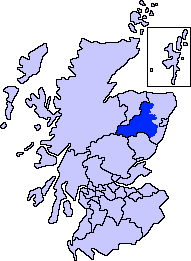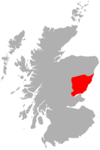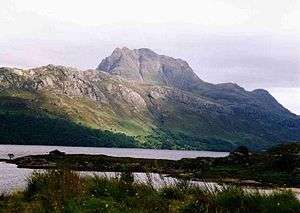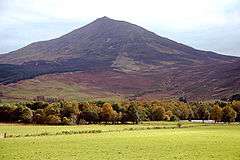Lochnagar
Lochnagar (/ˌlɒxnəˈɡɑːr/ (![]()
| Lochnagar | |
|---|---|
| Cac Carn Beag | |
 Lochnagar corrie in winter | |
| Highest point | |
| Elevation | 1,155 metres (3,789 ft) [1] |
| Prominence | 671 metres (2,201 ft) |
| Parent peak | Ben Avon |
| Isolation | 19.21 km (11.94 miles) [2] |
| Listing | Munro, Marilyn |
| Coordinates | 56°57′17″N 3°14′25″W |
| Naming | |
| English translation | Little loch of the noisy sound / possibly breast shaped mountain |
| Language of name | Gaelic |
| Pronunciation | Scottish Gaelic: [peɲˈçiəxən] |
| Geography | |
 Lochnagar | |
| Parent range | Grampian Mountains |
| OS grid | NO244861 |
| Topo map | OS Landranger 44 |
Names
Technically, the English name is a misunderstanding, being named after Lochan na Gaire, the 'little loch of the noisy sound', a loch to be found in the mountain's northeast corrie. Today the lochan is popularly called Lochnagar too. The summit itself may be referred to as Cac Càrn Beag,[3] meaning "small cairn of faeces" in Scottish Gaelic, or less euphemistically, 'little pile of shit'.[3] Peter Drummond, former chairman of the Architectural Heritage Society of Scotland, has also suggested that cac is a corruption of cadha ('slope'), which would lend a translation of little cairn of the slope.[3]
Lochnagar's alternative name, Beinn Chìochan (mountain of breasts), is probably the original Gaelic name for the mountain.[4][5]
Geography
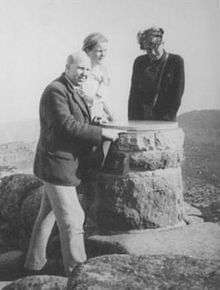
Lochnagar is located on the Royal Estate of Balmoral.[6] Its principal feature is a north-facing corrie, around which most of the subsidiary tops, as well as the main peak, sit. The corrie is the location of many classic summer and winter climbing routes.[7] The mountain is a Munro and is popular with hillwalkers at all times of the year, with the most common ascent route being from Glen Muick.[8] Care should be taken on the summit in poor visibility: the plateau has few obvious features and has steep cliffs on its northern edge.
Climate
Lochnagar's summit experiences an Alpine Tundra Climate, with freezing, snowy winters and cool summers. The nearest UK Met Office weather station is at Braemar 6.6 miles (10.6 km) northwest. The yearly temperature range is usually between −6.6 °C (20.1 °F) and 9.4 °C (48.9 °F), but it can be slightly warmer and colder. January has the highest average frosts, despite February nights being colder; January has an average of 26.9 frost days, compared with 24.3 in February. There is the risk of a frost at any time of the year, even in July and August, when each month averages 1 air frost every 10 years.[9][10]
Nature and conservation
Lochanagar lies within the Cairngorms National Park, and also gives its name to Deeside and Lochnagar National Scenic Area, one of 40 such areas in Scotland.[11] The designated national scenic area is 39,787 hectares (98,320 acres) in size,[12] and covers the mountains surrounding Lochnagar as far south as the head of Glen Doll, as well Deeside to the north.[13]
The mountain forms part of two designated Special Protection Areas, [14] due to its importance for breeding dotterel (Charadrius morinellus)[15] and golden eagles (Aquila chrysaetos).[16]
Cultural references
Due to its location on the Balmoral estate the mountain has many royal links, and Queen Victoria climbed to the summit in 1848.[7] In the film Mrs. Brown, John Brown and Benjamin Disraeli hike up Lochnagar to discuss the need for the Queen to return to active involvement with government. It is also the setting for a children's story, The Old Man of Lochnagar, originally told by Prince Charles.
The poet Lord Byron spent time in the area in his youth,[17] and wrote the poem, Lachin y Gair (also known as Dark Lochnagar), which also forms the basis of a song:
England! thy beauties are tame and domestic,
To one who has rov'd on the mountains afar:
Oh! for the crags that are wild and majestic,The steep, frowning glories of dark Loch na Garr
— Byron[7]
A malt-whisky distillery located near the Balmoral estate on the south side of the River Dee produces the Royal Lochnagar Single Malt whisky.
See also
- Breast-shaped hill
- Lochnagar crater: The site of the largest single mine of World War I, exploded at the beginning of the Battle of the Somme. Dug from a communication trench named "Lochnagar Street".
References
- "Cac Carn Beag (Lochnagar)". munromagic.com. Munro Magic. Retrieved 2013-10-13.
- "Locnagar isolation".
- Townsend, Chris (30 March 2011). Scotland. Cicerone Press Limited. p. 265. Retrieved 2018-03-15.
- "Lochnagar". An Stòr-dàta Briathrachais Gàidhlig. University of the Highlands and Islands. Retrieved 10 June 2018.
- Mitchell, Ian (2004). Scotland's Mountains Before the Mountaineers. Luath Press. p. 63. ISBN 0946487391.
- "Property Page: Balmoral (Aberdeen part) and Birkhall". Who Owns Scotland. Retrieved 1 March 2018.
- Ken Wilson and Richard Gilbert (1982). The Big Walks. Diadem Books. p. 78. ISBN 0-906371-60-0.
- Donald Bennett, ed. (1985). The Munros=, SMC Hillwalkers' Guide. Scottish Mountaineering Trust. p. 122. ISBN 0-907521-13-4.
- "Lochnagar climate information". UK Government Met Office. Retrieved 2018-01-13.
- "Does Elevation Affect Temperature?". On The Snow. 11 December 2017. Retrieved 2018-01-13.
- "National Scenic Areas". Scottish Natural Heritage. Retrieved 17 January 2018.
- "National Scenic Areas - Maps". Scottish National Heritage. 20 December 2010. Archived from the original on 12 June 2018. Retrieved 28 February 2018.
- "Map: Deeside and Lochnagar National Scenic Area" (PDF). Scottish Natural Heritage. 20 December 2010. Retrieved 28 February 2018.
- "Sitelink - Map Search". Scottish Natural Heritage. Retrieved 1 March 2018.
- "Site Details for Lochnagar". Scottish Natural Heritage. 1 February 2018. Retrieved 1 March 2018.
- "Site Details for Cairngomes Massif". Scottish Natural Heritage. 1 February 2018. Retrieved 1 March 2018.
- Black's Guide to Scotland, 33rd Edition (1903). p. 232.
